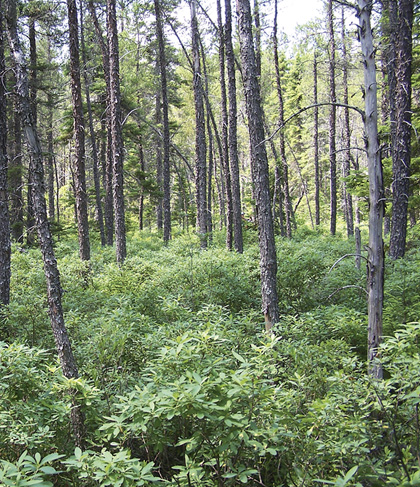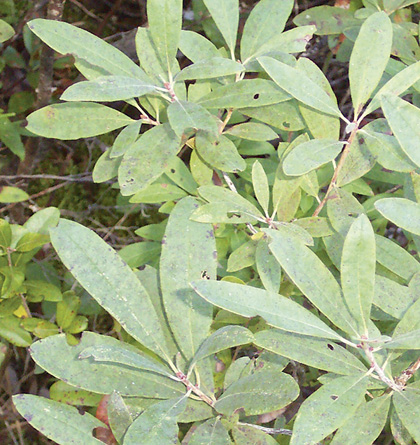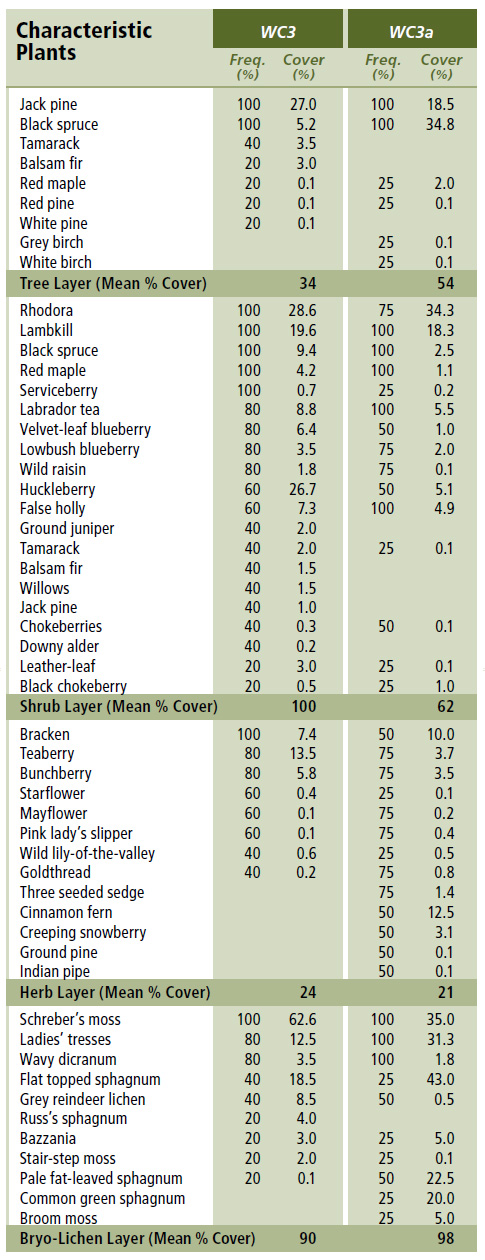
Forest Vegetation types - WC3
WC3 — Jack pine – Black spruce / Rhodora / Sphagnum
Pinus banksiana – Picea mariana / Rhododendron canadense / Sphagnum spp.
WC3a — Black spruce variant
Picea mariana
 |
Thomson Station, Cumberland County |
Concept: The Jack pine – Black spruce / Rhodora / Sphagnum is the wettest jack pine forest in Nova Scotia. Most occurrences are on poorly to very poorly drained soil, derived from acidic glacial till or, less commonly, organic deposits. The overstory is dominated by jack pine, or co-dominated by jack pine and black spruce; the latter condition described by WC3a, the black spruce variant.
Vegetation: Canopy layers are dominated by jack pine (or co-dominated by jack pine and black spruce). Tamarack and/or balsam fir are infrequent associates. Limiting site conditions and the prevalence of inherently small crowned conifers reduces canopy closure and promotes shrub abundance. Rhodora is present and usually dominant in most stands, with admixtures of lambkill and/or Labrador tea. Huckleberry is less common but abundant in some occurrences. Jack pine regeneration is low or absent from the understory. Herbaceous cover is reduced, largely comprised of scattered teaberry, mayflower and other common upland forest species. Bracken fern, mayflower, hair-cap moss and wavy dicranum are more frequent than in any other wet coniferous forest in Nova Scotia. Sphagnum moss, particularly ladies' tresses, and small patches of upland species are typical in the well-developed bryophyte layer.
Environmental Setting: The Jack pine - Black spruce / Rhodora / Sphagnum forest usually occurs on poorly drained mineral soil, but may be found on peat deposits. Mineral soils are acidic loams with reduced rooting potential. Some stands are on imperfectly drained sites but most are poorly or very poorly drained; organic soils are found on the wettest sites. This low elevation ecosystem is usually on moderately exposed flats but may be found in lower topographic positions of gentle slopes or in shallow depressions with very little microtopography. Sloped occurrences are usually found on cooler aspects. This uncommon forest is largely limited to northern and central parts of the mainland and parts of Cape Breton. WC3 extends into lowlands of eastern New Brunswick, where it is relatively common, and onto Prince Edward Island where it is extremely rare.
Successional Dynamics: This early to mid-successional forest usually originates with fire, promoting jack pine regeneration. Extreme weather events can dry litter, surface soil horizons, and the somewhat flammable ericaceous plant layer to allow these normally wet stands to burn. Such conditions are uncommon however and many stands form through seed-in from adjacent uplands. The Jack pine – Black spruce / Rhodora / Sphagnum forest will succeed to WC2 (Black spruce / Lambkill – Labrador tea / Sphagnum).
Ecological Features: An open canopy of narrow-crowned conifers characterizes this very uncommon small patch ecosystem. The woody understory is dense with ericaceous shrubs and black spruce. Productivity is low, few rare plant species are expected, and old growth potential is low. This wet forest is often a transition between open wetlands and upland coniferous forest, providing important hydrologic and biogeochemical functions. Reduced productivity and the presence of allelopathic plants (those that produce biochemicals that affect nearby plants) like lambkill can negatively influence black spruce regeneration and growth, resulting in lower canopy cover. Occurrences may provide locally if not provincially important habitat for various invertebrates, birds, amphibians, small mammals, reptiles and lichens. By virtue of its rarity, restricted Canadian range and fire dependency, this ecosystem may present unique conservation challenges.
 |
| Rhodora |
Distinguishing Features: Jack pine is diagnostic of this poorly drained softwood forest. The woody shrub layer is well developed with rhodora, lambkill and Labrador tea. Sphagnum mosses dominate the groundcover.
| Slope Position: | Level7 Lower2 Upper1 |
Surface Stoniness: |
(Non - Slightly)10 |
Bedrock Outcrop: |
(Non-rocky)9 (Slightly - Moderately)1 |
Elevation Range: |
12 - 110m |
Slope Gradient: |
Level7 Gentle3 |
Aspect: |
East1 South3Other6 |
Exposure: |
Moderate8 Mod. exposed2 |
Microtopography: |
Level9 Slightly1 |
Drainage: |
Poor6 Very poor2 Imperfect2 |
Soil Type: |
ST46 ST62 ST72 |
Parent Material: |
Glacial till9 Glaciofluvial1 |
Rooting Depth (cm): |
(<30)9 (30-45)1 |
Duff Thickness (cm): |
(6-10)1 (11-20)8 (21-40)1 |

